They say… 
Best beer and travel writing award 2015, 2011 -- British Guild of Beer Writers Awards
Accredited Beer Sommelier
Writer of "Probably the best book about beer in London" - Londonist
"A necessity if you're a beer geek travelling to London town" - Beer Advocate
"A joy to read" - Roger Protz
"Very authoritative" - Tim Webb.
"One of the top beer writers in the UK" - Mark Dredge.
"A beer guru" - Popbitch.

|
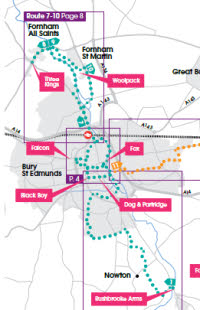 The Great Blighty Ale Trail If exploring real ale pubs, country footpaths and historic towns sounds to you like a great way to spend a day, you should check out the downloadable walks booklet I’ve compiled for UKTV’s Blighty channel as part of this summer’s Great Ale Trail promotion, featuring walks around Bury St Edmunds. See http://uktv.co.uk/blighty/homepage/sid/8361/homepageID/3926/.
At the beginning of June I spent several demanding but enjoyable days walking a total of around 100km to research walking routes linking 20 pubs, all of them serving cask beer, in Bury and its surrounding villages. The pubs had already been chosen by UKTV so inevitably there are some places where finding good off-road routes proved too much of a challenge. Consequently there’s a little more road walking than I’d normally like, but there are some fantastic routes too, through rich and green but generally flat and easy countryside.
I’m especially pleased with the linear route that starts at Sicklesmere and runs north along the river Lark through country parks and water meadowns into Bury, where there are two alternative routes either through the mediaeval streets or the abbey gardens, continuing along the valley to the Fornhams. The routes east of Pakenham and Ixworth are also particularly delightful, including old mills, woodlands, former Roman vineyards and marshes.
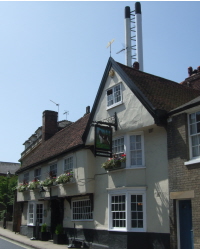 Dog and Partridge, Bury St Edmunds Inevitably many of the pubs are Greene King houses but there are some classic free houses too, offering a range of East Anglian beers. I didn’t manage to get inside all of them and the need to drive prevented me from sampling the beer offer in some of ones I did visit, but I had a particular welcome in the 15th century White Horse at Badwell Ash and the Blue Boar at Walsham Le Willows.
Sadly the most unmissable pubs I found in Bury weren’t included in the list I was sent, so I’ll recommend them now. The Old Cannon brewpub in Cannon Street has some fine own-brewed ales, locally craft-brewed lager, good food and a tasteful choice of British and imported bottled beers in a clean and modern but relaxing ambience. The essential Greene King house is the Rose and Crown, on the corner of Whiting Street and Westgate Street, a genuine retro local that serves GK and guest ales, including hard to find XX Mild, in flawless condition. I also took the chance to visit Greene King’s brewery: more here.
For those who prefer a slightly faster mode of travel, Bury and several of the villages lie along National Cycle Network route 51, and there’s even a chance to win Millets vouchers before 23 August.
Originally published in BEER November 2009.
The British have an issue with strong beer. In a beer culture centred round swilling down several pints at 4 per cent ABV or less, there’s a tendency to see higher gravities as a route to quicker inebriation. It’s not surprising, then, that British bottle conditioned strong ales are still relatively scarce. A shame, as stronger beers generally do better as real ale in a bottle than weaker ones – the danger of infection is reduced, and there’s more potential for developing complexity with age.
Of course, as anyone familiar with Belgian beer culture will know, it’s possible to enjoy strong beer responsibly by taking it slowly and in moderation. Contemplative sipping has its own rewards, so with the nights drawing in, it’s time to raise a small glass to the British brewers who offer something worth contemplating – as well as a Scandinavian visitor well worth seeking out.
Pitfield Brewery is one of the pioneers of the British microbrewing revival, and now offers a range of historical recreations at gravities that predate the ubiquity of “session strength”, such as the annually brewed Pitfield XXXX Stock Ale (10 per cent). Based on a recipe for the 1890s when stock ale meant strong beer laid down for later blending, it’s a characterful full-bodied, peppery and mouth-filling amber ale with hints of roast and smoke.
In between turning out batches of best selling Doom Bar, Sharps brewer Stuart Howe has developed some more esoteric specialities, including the appropriately named Sharps Massive Ale (10 per cent). This burgundy brew with a slight Belgian accent, hopped with Perle and Northdown, could mature for up to a decade but is already heady and complex, with cherries on the aroma, a figgy berry note on the palate and a mellow orange malty finish, tinged with vermouth and balsamic onions.
Another historical recreation is Woodfordes Norfolk Nip (8 per cent), based on a barley wine from former Norfolk brewery Steward and Patteson, closed by Watney in 1970. I’ve kept bottles of this dark ruby beer for five years and found it rich with toffee apple, custard and wine-like notes, touches of mint and olives and spicy rounded hops.
Something genuinely unusual is Thornbridge Bracia (9 per cent) from Derbyshire. It includes chestnut honey from brewer Stefano Cossi’s native Italy – along with no less than six malts, four hop varieties and roast barley. Honey is obvious on the aroma of this near-black brew, and a sweetish and cakey but extremely complex palate has lightly bittering herbs, savoury notes and peat, with a warming coffeeish finish.
No roundup of winter brews would be complete without a real imperial stout, and one of the very best I’ve tasted comes from under the flight path of Copenhagen airport, and the shadow of mighty Carlsberg. Amager Imperial Stout (10.1 per cent) is one of a number of exciting beers now emerging from Scandinavia, dark brown with chocolate, vanilla and exotic spice on the aroma, a rich chocolate palate with a petrolly note and pursing dry roast over sappy malt in the finish.
With this post I’ve finally caught up with myself as far as my reviews in BEER are concerned — all of them are now archived, except for the most recent which are on an agreed three-month delay after publication. Hurrah!
Featured as a strong ale for winter in BEER November 2009. For more strong beers see previous post.
ABV: 9%
Origin: Ashton-in-the-Water, Derbyshire, England
Website: www.thornbridgebrewery.co.uk
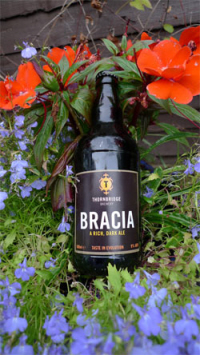 Thornbridge Bracia. Pic by Andy of beerreviews.co.uk, used by permission. Rising star of British craft breweries Thornbridge have an impressive range of unusual beers but perhaps this is the most remarkable one they’ve produced so far, although it won’t be to everyone’s taste. It certainly caused a stir when chosen as the beer to match the dessert course at the British Guild of Beer Writers’ dinner in 2008.
According to the brewery, it’s based on a Celtic beverage allegedly called Bracia that involved cereals and honey, although this account has been challenged. Whatever the truth, the Thornbridge interpretation is a complex creature, with an ingredients list that runs to Maris Otter pale, brown, Munich, dark crystal, black, chocolate and peated malt, roasted barley, Target, Pioneer, Hallertau Northern Brewer and Sorachi Ace hops, chestnut honey from beekeper Onelia Pin, based near brewer Stefano Cossi’s former home in northeast Italy. The whole is fermented with champagne yeast and should mature for at least a year.
This is a black beer with a big, thick brown head and a dark malt, honey, date and spice aroma. A thick and cakey gravy, peat and leather palate is mainly sweet but with complex bittering herbs, perhaps a tangy of savory and a definite splash of roast coffee. A very long and tasty warming but fresh vegetal finish has more dates, late emerging honey and a roast barley and bittering hop bite just about offsetting the sweetness.
Whatever you make it, be thankful there are now brewers in Britain contemplating leftfield brews like this.
The final beer selected for this piece was Amager Imperial Stout.
Read more about Thornbridge Bracia at ratebeer.com: http://www.ratebeer.com/beer/thornbridge-bracia/97342/
Featured in BEER November 2009 as a strong ale for winter drinking. For similar beers, see previous post.
ABV: 8%
Origin: Woodbastwick, Norfolk, England
Website: www.woodfordes.co.uk
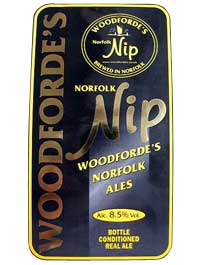 Woodforde's Norfolk Nip Established in 1980, Woodforde’s is now quite a veteran, and a leading player in the burgeoning microbrewing scene of East Anglia. As well as a number of standout cask products, its range is immensely strengthened by bottle conditioned beers, including a number of strong options. One such is this minor classic barley wine, based on a 1929 recipe from Norwich’s Steward & Patterson’s brewery, brewing of which ceased in the early 1960s under the ownership of Watneys, who later shut the brewery. The brand name was preserved as the title of the local CAMRA magazine, and Woodforde’s recreated the beer to celebrate the 10th anniversary of that publication in 1992. It’s since become an annually released limited edition special, brewed from Maris Otter pale, crystal and chocolate malt, roasted barley and Goldings hops and matured for six months before being racked and bottled with unfermented wort.
A vintage dated 1999 bottle on sale at the Great British Beer Festival in 2001 and tasted two years later turned out a very dark burgundy, with a low yellow head, a mellow malty liquorice aroma with faint spice and perhaps some banana, and a smooth palate developing roasted malt, blackcurrant, nuts and enlivening hops. A smooth swallow led to a roasty finish with mellow hops, chocolate, warming alcohol and late bitterness, very soothing but not sweet.
In 2002 I bought two more bottles, no longer vintage dated but with a best before date of August 2004, and tasted the first relatively young. This was a dark ruby beer with a very thick off-white head and a rich malty toffee-apple aroma with apple core and custard hints. The palate was smooth and malty but surprisingly light, fizzy and winy, with stewed apple notes. A cleansing swallow heralded a warming rounded hop finish with more toffee apple, again very long and quite fruit, with a late bitterness. The second bottle didn’t age as well as I expected — tasted in December 2006, it had gained sherry, mint and olive notes but seemed to have started to deteriorate.
Read more about strong ales for winter in next post.
Read more about this beer at ratebeer.com: http://www.ratebeer.com/beer/woodfordes-norfolk-nip/18393/
Featured in BEER November 2009 as a strong ale for winter drinking. For more beers in this piece, see previous post.
ABV: 10%
Origin: Rock, Cornwall
Website: www.sharpsbrewery.co.uk
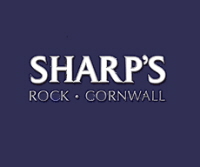 Sharp's Brewery Massive Ale is one of Sharp’s brewer Stuart Howe’s bottled specialities, an exciting sideline with a distinct Belgian influence for one of the more successful new cask producers. It’s a big dark barley wine, with candy sugar added to the grist and doses of Perle and Northdown hops. Bottle conditioned, it’s intended to mature for up to 10 years.
The beer poured a cloudy burgundy with a fine creamy off-white head and a heady and complex rich malt aroma with cherry and figs. Figs returned along with red berries on a sweetish malty palate with what appeared to be coriander hints, although the herb isn’t declared. There were wood and balsamic onion notes on a mellow dark orange malt finish which seemed a little reserved compared to the palate, with a slight note of Vermouth.
For more strong ales for winter drinking, see next post.
Read more about this beer at ratebeer.com: http://www.ratebeer.com/beer/sharps-massive-ale/92666/
This beer featured in BEER November 2009 in a piece about strong ales for winter.
ABV: 10%
Origin: North Weald, Essex, England
Website: www.pitfieldbeershop.co.uk
 Pitfield's 1896 XXXX Stock Ale Pitfield Brewery is one of the pioneers of the British microbrewing revival, originally set up in 1981 in Pitfield Street, Hoxton, in the days long before the area became associated with edgy club culture, as a home brewing and specialist beer shop. In its latter function it was one of the first in the UK and over the years introduced grateful drinkers not only to British craft brews but to all manner of imported delights from mainland Europe and elsewhere. In 1982 a brewery was added, which gained a high reputation in the second half of the decade for its innovative and award winning premium strength Dark Star. By 1990 the original partnership had dissolved, and though the shop remained open, brewing ceased for a while, then two successors emerged: the Dark Star brewery in Brighton and, from 1996, a revived Pitfield Brewery in Hoxton, which as it progressed into the new millennium specialised more and more in organic beers. In 2006, under pressure from rent rises thanks to neighbours who fancied themselves as New British Artists, the shop closed and the brewery relocated, along with a mail order service, to Essex. As of 2008, there’s a retail outlet once again, as part of Ashlyns Farm Shop.
Just before closing in London, Pitfield had been experimenting with a fascinating range of historical recreation ales, departing from the general organic policy in order to source relatively authentic ingredients, and many of these are still around since the move. Stock Ale is made from Maris Otter barley malt, crystal malt and Northdown hops, following a recipe in the Durden Park Beer Circle’s book Old British Beers and How To Make Them. Stock ale was a term for a very strong ale, kept for long periods at a brewery and often used for blending.
Issues of the beer are now vintage dated, the most recent in 2007, but my first taste of it was in 2004, when I discovered a slightly fizzy peachy amber beer with a yellowish loose head and a dusky orange aroma, with stony hops, roast malt, olives, pepper and spicy hints that reminded me of the Indian breath freshener, pan. A thick and full bodied but dry palate had herbal hops and salty bitter orange, and a warming swallow led to a dry hoppy and smoky mouth-filling finish with more bitter orange and alcohol rounding off a vivid and characterful beer.
See next post for more strong ales.
Read more about this beer at ratebeer.com: http://www.ratebeer.com/beer/pitfield-1896-xxxx-stock-ale/27423/
First published in BEER August 2009.
 Jeff Evans, The Good Bottled Beer Guide, 7th edition The Great British Beer Festival sees the launch of the 7th edition of CAMRA’s Good Bottled Beer Guide, the swelling dimensions of which bear eloquent testimony to the resurgence of UK Real Ale in a Bottle. With each edition editor Jeff Evans uncovers inviting new entries on the wants list, and this one is no exception. Here I’ve tasted five beers new to the Guide, including four débuting breweries.
Nigel Wright’s Hopshackle Brewery in Market Deeping, Lincolnshire, established in 2006 and specialising in superb beers based on historic styles, is one of the real discoveries. His Double Momentum (7 per cent) is an unusual British take on an Imperial IPA, worthy of cellaring. Dosed with generous quantities of Challenger and Goldings and cask aged for at least two months before bottling, this is a golden ale rich in honeyed flowers and ripe plum fruit, with a marvellously complex citrus and rose palate and a rooty, peppery finish, the hops big but smooth around the edges and not overbearing.
Also dating from 2006 is Spire Brewery in Chesterfield, borrowing for its logo the town’s twisted spire landmark. No doubt brewer David McLaren’s former career as a bandsman in the Scots Guards has something to do with the surprising presence, among an already unusual range of ales, of an extremely rare beast: a bottle conditioned Scottish 80/-. 80 Shilling Ale (4.3 per cent) is a mid-brown beer with a toasty aroma and a rich malty, sappy, chewy palate with tart gooseberry notes, finishing roasty dry with a touch of salt.
Newer still is the immodestly named Outstanding Brewery in Bury, launched in 2008 – although the involvement of one of Britain’s leading suppliers of microbrewing kit, David Porter, shows an experienced hand, as does the wide range of beers, from smoked ales to Californian-style extreme hop brews. The one I enjoyed most, though, was a simple classic bitter, OSB (4.4 per cent), full of ripe autumn fruit and biscuity malt, with orange and peach syrup softening a firm bitter finish.
Imperial Stout Acorn Gorlovka, named after the Ukrainian twin town of the brewery’s Barnsley base, is an impressive bottle conditioned début from a renowned cask supplier. At 6 per cent, a relatively low gravity for the style, this still packs plenty of flavour, with cream, nut, blackcurrant, chocolate, coffee and leather, a good wallop of hops and a dash of farmyard aroma – a great addition to the Imperial Stout family.
Old Chimneys in Market Weston, Suffolk, is a Guide veteran for brewer Alan Thomson’s unusual and inventive ales. Among his new beers is Amber Porter (4.8 per cent), based on brewing records from 1785-1827 rescued from Ipswich’s defunct Tolly Cobbold brewery. Authentically reddish brown rather than black, this has a big malt aroma and a smooth but very toasty palate and follows through with tart fruit, charred wood and chocolate.
With Real Ale in a Bottle in such good health, who knows what delights the 8th edition of the Guide will bring?
Buy the books from amazon.com:
See also Jeff Evans’ Inside Beer page.
Featured as a selection from the new Good Bottled Beer Guide in BEER August 2009. For more selections see previous post.
ABV: 4.8%
Origin: Market Weston, Suffolk, England
Website: www.oldchimneysbrewery.com
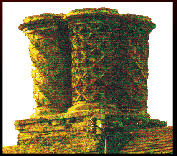 Old Chimneys Brewery Former Greene King, Vaux and Broughton brewer Dr Alan Thomson has consistently produced small runs of innovative beers from his Suffolk micro and Old Amber is no exception. It’s an experimental historical recreation based on a recipe found in Tolly Cobbold’s brewing archive, documenting a beer that was on their books between 1785 and 1827, and although it’s unusually light in colour for a modern porter, the colour is quite likely faithful to the brown malt of the times. Alan admits the beer isn’t to his own personal taste, but it’s a fascinating insight into the beers of two centuries ago.
Made with floor malted barley matching as closely as practical the specification of the times, it’s hopped with traditional varieties from Suffolk and Maidstone, Kent, and triple fermented, with a secondary fermentation in cask then a third in the bottle.
The result is dark burgundy with a pinky beige foam head and a restrained cereal malt and chocolate aroma. The dark malt palate is dry, milky and toasty with tart fruit and mineral hints, very slick in the mouth, leading to a roasty charred chocolate finish. A slightly acidic hint lifts an overall smoothness that’s slightly understated, and actually quite elegant for the style.
Read more about this beer at ratebeer.com: http://www.ratebeer.com/beer/old-chimneys-amber-porter/80319/
Featured as a selection from the new Good Bottled Beer Guide in BEER August 2009. For more selections see previous post.
ABV: 6%
Origin: Barnsley, South Yorkshire, England
Website: www.acornbrewery.net
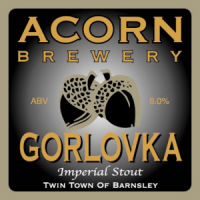 Acorn Gorlovka Imperial Stout Acorn brewery has its origins in the old Barnsley Brewery, well known for its Barnsley Bitter. When this went into liquidation, eventually merging with Blackpool Brewery, brewer Dave Hughes set up his own as Acorn, continuing to brew Barnsley Bitter using the original yeast. Acorn enhanced a well-deserved reputation built on its cask beer in 2009 when it launched its first bottle conditioned line, an imperial stout named after Barnsley’s Ukrainian twin town, known as Gorlovka in Russian, though Gorlyivka in Ukrainian. This beer also uses the renowned Barnsley yeast.
This is a very dark mahogany beer with a big foamy beige head and a big aroma of chocolate, coffee, leather, spiced cream and slight farmyard whiffs. A dry and roasty but lightly textured black cherry fruit and chocolate palate with nuts and a wallop of hops. The finish is very dry and ashy with bitter roast coffee and burry hops, still very impressive though a little more straightforward than the aroma and palate will lead you to expect. At a relatively low gravity for the style, this still packs a lot of flavour, and is a great addition to the range of imperial stouts brewed in Britain.
For more selections from the Good Bottled Beer Guide 2009 see next post.
Read more about this beer at ratebeer.com: http://www.ratebeer.com/beer/acorn-gorlovka-imperial-stout/65504/
Featured in BEER August 2009 as a selection from the latest Good Bottled Beer Guide. For more selections see previous post.
ABV: 4.4%
Origin: Bury, Greater Manchester, England
Website: www.outstandingbeers.co.uk
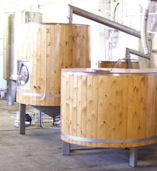 Outstanding Brewery The immodestly named Outstanding Brewery in Bury, Greater Manchester, was launched only in 2008, although the involvement of one of Britain’s leading suppliers of microbrewing kit, David Porter, shows an experienced hand. With the help of collaborators Paul Sandiford and Glen Woodcock, he’s developed a wide and imaginative range of beers, from smoked ales to Californian-style extreme hop brews. The brewery sent me a generous selection, but the one I enjoyed most was a simple classic bitter, OSB.
This is a copper-brown coloured ale with a declining bubbly light beige head. A resiny hopsack aroma has notes of toast and ripe autumn fruit, and the palate is also very fruity and biscuity, with a definite though not overpowering hop bite, notes of washing up liquid and peach syrup. A long and lightly roasty finish has rooty well-balanced hops and a touch of chocolate.
For more selections from the 2009 Good Bottled Beer Guide see next post.
Read more about this beer at ratebeer.com: http://www.ratebeer.com/beer/outstanding-osb/112893/
|
Cask  This pioneering new book explains what makes cask beer so special, and explores its past, present and future. Order now from CAMRA Books. Read more here. This pioneering new book explains what makes cask beer so special, and explores its past, present and future. Order now from CAMRA Books. Read more here.
London’s Best Beer  The fully updated 3rd edition of my essential award-winning guide to London’s vibrant beer scene is available now from CAMRA Books. Read more here. The fully updated 3rd edition of my essential award-winning guide to London’s vibrant beer scene is available now from CAMRA Books. Read more here.
|














